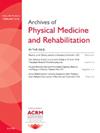Organizational Characteristics of Medical-legal Partnerships Serving People Living with HIV: Challenges and Opportunities
IF 3.6
2区 医学
Q1 REHABILITATION
Archives of physical medicine and rehabilitation
Pub Date : 2025-04-01
DOI:10.1016/j.apmr.2025.01.070
引用次数: 0
Abstract
Objectives
To investigate what characteristics and strategies of medical-legal partnerships (MLPs) proved to invaluable to improving outcomes for people with HIV (PWH). To understand the potential benefits of MLPs and challenges with their implementation.
Design
A mixed-method analysis was conducted using both categorical features of MLPs, including the person who carries out the screening for health harming legal needs, whether the MLP was community-based or an organization, and how legal services were provided, and number of services offered on-site or referral based on responses to a cross-sectional survey of MLPs. We conducted a multiple variable linear regression analysis with these variables in association to the main outcome measures.
Setting
We used an online survey questionnaire to gather data for the study.
Participants
Data came from a cross-sectional survey of MLP providers through a national survey of clinics, community-based organizations, and hospitals across the United States. This data used for this study used survey data from a previous NIH study that was already completed with prior IRB approval done. The data did not collect identifiable information about themselves or their patients and were compensated with a $30 gift card. Inclusion criteria for this survey were organizations that had a patient population with over 50% of their patients living with HIV.
Interventions
No intervention was carried out.
Main Outcome Measures
Percentage of patients in their clinic that have achieved HIV viral suppression and percentage of patients completing a follow-up appointment every 6 months.
Results
Analysis showed that having clinician posing as the initial screener for health harming legal needs was associated with a lower likelihood of completing a follow-up appointment for PWH (P<.05). We also found the community health organizations were associated with a greater number of patients achieving a suppressed HIV viral load (P<.10). Finally, we found that that the number of on-site services were associated with an improvement with bout outcome measures.
Conclusions
Study findings highlight factors impacting outcomes in HIV care. Notably, clinician-led screening for health harming legal needs linked to reduced follow-up appointments for PWH, signaling an imperative for improved clinician training. The presence of community health organizations and on-site services emerged as key contributors to enhanced outcomes, emphasizing comprehensive care approaches in HIV care. Further research is needed to document best practices and approaches within medical-legal partnerships to improve HIV care outcomes.
Disclosures
none.
服务于艾滋病毒感染者的医疗-法律伙伴关系的组织特征:挑战与机遇
目的探讨医疗-法律伙伴关系(mlp)的哪些特征和策略对改善艾滋病毒感染者(PWH)的预后是无价的。了解mlp的潜在好处和实施过程中的挑战。DesignA采用MLP的两种分类特征进行了混合方法分析,包括筛查健康危害法律需求的人员、MLP是基于社区还是组织、提供法律服务的方式、现场提供的服务数量或基于对MLP横断面调查的反馈的转诊。我们对这些变量与主要结果测量的关联进行了多变量线性回归分析。我们使用在线调查问卷来收集研究数据。参与者数据来自对MLP提供者的横断面调查,通过对美国各地诊所、社区组织和医院的全国性调查。本研究使用的数据使用了先前NIH研究的调查数据,该研究已经完成并事先获得了IRB的批准。这些数据没有收集他们自己或病人的可识别信息,并获得了一张30美元的礼品卡作为补偿。该调查的纳入标准是患者人群中50%以上的患者携带艾滋病毒的组织。干预措施未进行干预。主要结果测量在其诊所中实现HIV病毒抑制的患者百分比和每6个月完成随访预约的患者百分比。结果分析显示,让临床医生充当危害健康的法律需求的初始筛选者,与较低的PWH后续预约完成可能性相关(P< 0.05)。我们还发现,社区卫生组织与更多达到HIV病毒载量抑制的患者相关(P<.10)。最后,我们发现现场服务的数量与一些结果测量的改善有关。结论研究结果突出了影响HIV护理结果的因素。值得注意的是,由临床医生主导的对危害健康的法律需求的筛查与PWH的后续预约减少有关,这表明必须改进临床医生培训。社区卫生组织和现场服务的存在成为提高成果的关键因素,强调艾滋病毒护理的综合护理方法。需要进一步研究,以记录医疗-法律伙伴关系中的最佳做法和方法,以改善艾滋病毒护理结果。
本文章由计算机程序翻译,如有差异,请以英文原文为准。
求助全文
约1分钟内获得全文
求助全文
来源期刊
CiteScore
6.20
自引率
4.70%
发文量
495
审稿时长
38 days
期刊介绍:
The Archives of Physical Medicine and Rehabilitation publishes original, peer-reviewed research and clinical reports on important trends and developments in physical medicine and rehabilitation and related fields. This international journal brings researchers and clinicians authoritative information on the therapeutic utilization of physical, behavioral and pharmaceutical agents in providing comprehensive care for individuals with chronic illness and disabilities.
Archives began publication in 1920, publishes monthly, and is the official journal of the American Congress of Rehabilitation Medicine. Its papers are cited more often than any other rehabilitation journal.

 求助内容:
求助内容: 应助结果提醒方式:
应助结果提醒方式:


